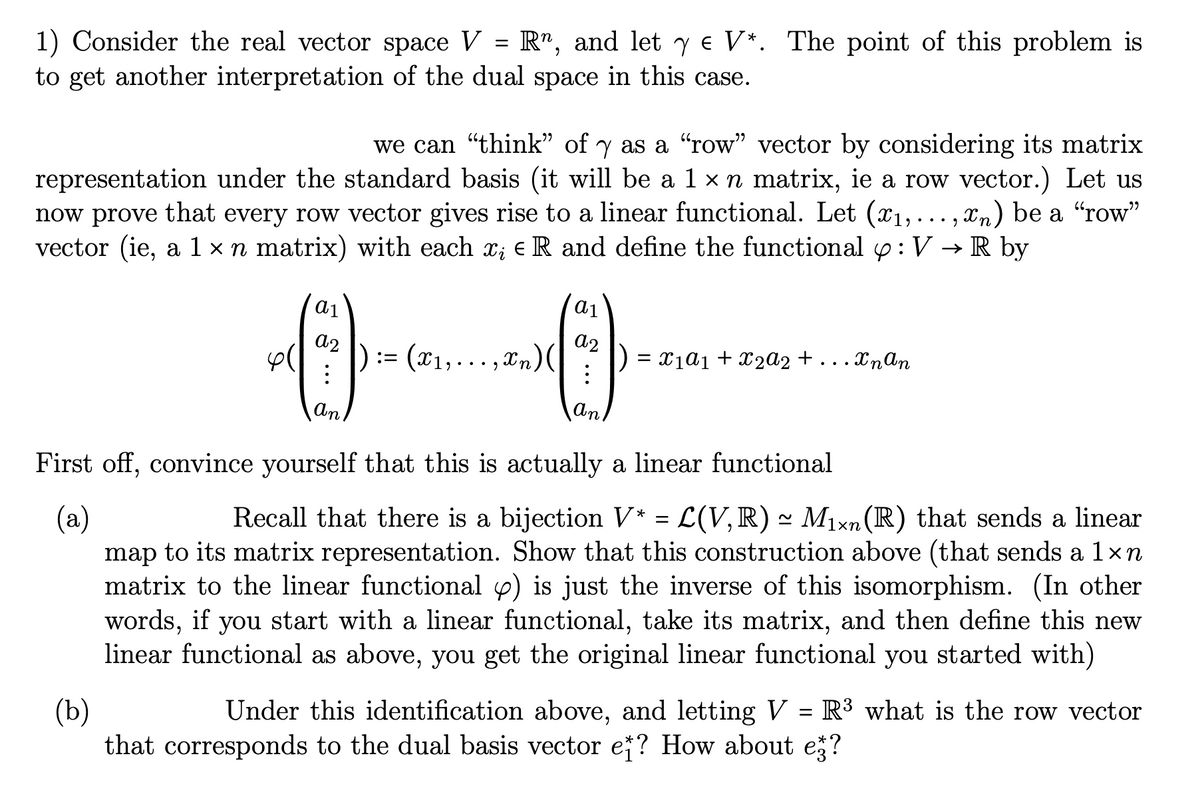1) Consider the real vector space V = R¹, and let y € V*. The point of this problem is to get another interpretation of the dual space in this case. we can "think" of y as a "row" vector by considering its matrix representation under the standard basis (it will be a 1 × n matrix, ie a row vector.) Let us now prove that every row vector gives rise to a linear functional. Let (x₁,...,xn) be a “row” vector (ie, a 1 x n matrix) with each x; € R and define the functional y : V → R by a1 - () -- a2 an := (x₁,...,xn) ( a1 a2 an = x₁α1 + x₂A2+...XnAn First off, convince yourself that this is actually a linear tional (a) ~ Recall that there is a bijection V* = L(V,R) ≈ M₁×n(R) that sends a linear map to its matrix representation. Show that this construction above (that sends a 1×n matrix to the linear functional y) is just the inverse of this isomorphism. (In other words, if you start with a linear functional, take its matrix, and then define this new linear functional as above, you get the original linear functional you started with) (b) Under this identification above, and letting V = R³ what is the row vector that corresponds to the dual basis vector ef? How about ež?
1) Consider the real vector space V = R¹, and let y € V*. The point of this problem is to get another interpretation of the dual space in this case. we can "think" of y as a "row" vector by considering its matrix representation under the standard basis (it will be a 1 × n matrix, ie a row vector.) Let us now prove that every row vector gives rise to a linear functional. Let (x₁,...,xn) be a “row” vector (ie, a 1 x n matrix) with each x; € R and define the functional y : V → R by a1 - () -- a2 an := (x₁,...,xn) ( a1 a2 an = x₁α1 + x₂A2+...XnAn First off, convince yourself that this is actually a linear tional (a) ~ Recall that there is a bijection V* = L(V,R) ≈ M₁×n(R) that sends a linear map to its matrix representation. Show that this construction above (that sends a 1×n matrix to the linear functional y) is just the inverse of this isomorphism. (In other words, if you start with a linear functional, take its matrix, and then define this new linear functional as above, you get the original linear functional you started with) (b) Under this identification above, and letting V = R³ what is the row vector that corresponds to the dual basis vector ef? How about ež?
Linear Algebra: A Modern Introduction
4th Edition
ISBN:9781285463247
Author:David Poole
Publisher:David Poole
Chapter6: Vector Spaces
Section6.2: Linear Independence, Basis, And Dimension
Problem 15EQ
Related questions
Question
100%

Transcribed Image Text:1) Consider the real vector space V = R", and let y € V*. The point of this problem is
to get another interpretation of the dual space in this case.
we can "think" of y as a "row" vector by considering its matrix
representation under the standard basis (it will be a 1 × n matrix, ie a row vector.) Let us
now prove that every row vector gives rise to a linear functional. Let (x₁,...,xn) be a "row"
vector (ie, a 1 × n matrix) with each x; € R and define the functional : V → R by
00
) := (x₁,...,xn) (
a1
a2
:
An
a1
a2
an
= x₁α1 + x₂a2 + . Xn An
First off, convince yourself that this is actually a linear functional
(a)
Recall that there is a bijection V* = L(V, R) ~ Mixn (R) that sends a linear
map to its matrix representation. Show that this construction above (that sends a 1xn
matrix to the linear functional p) is just the inverse of this isomorphism. (In other
words, if you start with a linear functional, take its matrix, and then define this new
linear functional as above, you get the original linear functional you started with)
(b)
Under this identification above, and letting V = R³ what is the row vector
that corresponds to the dual basis vector ef? How about e?
Expert Solution
This question has been solved!
Explore an expertly crafted, step-by-step solution for a thorough understanding of key concepts.
Step by step
Solved in 8 steps with 7 images

Recommended textbooks for you

Linear Algebra: A Modern Introduction
Algebra
ISBN:
9781285463247
Author:
David Poole
Publisher:
Cengage Learning

Elementary Linear Algebra (MindTap Course List)
Algebra
ISBN:
9781305658004
Author:
Ron Larson
Publisher:
Cengage Learning

Linear Algebra: A Modern Introduction
Algebra
ISBN:
9781285463247
Author:
David Poole
Publisher:
Cengage Learning

Elementary Linear Algebra (MindTap Course List)
Algebra
ISBN:
9781305658004
Author:
Ron Larson
Publisher:
Cengage Learning